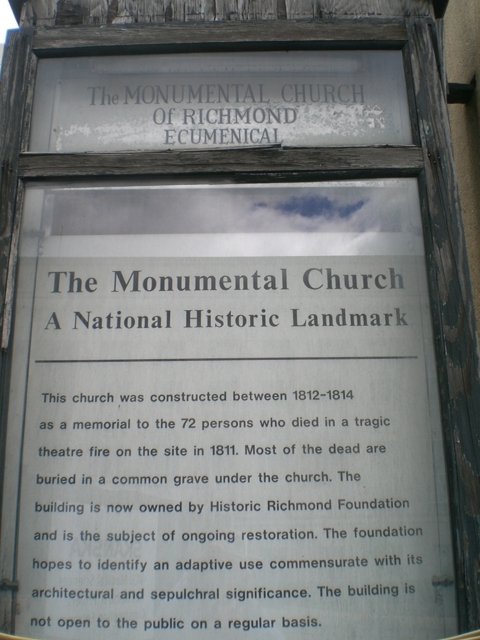Monumental Church
Monumental Church stands as a National historic landmark in Richmond. It was built in memory of the` 72 people who died in a Richmond theatre fire on the day after Christmas in 1811. The church was designed by the South Carolina architect, Robert Mills, whose plan for the church’s design was chosen specifically because of the way he combined the architectural designs of both monument and church. The church, which has been called “an architect’s paradise, a geometrically ordered building full of optical illusions and sweeping curves,” has significance in American history because of its contribution to culture, architecture and society.
 Mills described his plan for the church as “Giving a sacred and lasting character to this structure by the erection of a temple for divine worship, making entrance to it through a monumental hall-the whole edifice to be under the title of Monumental Church.” The portico, or “monument,” of the building features six Greek Doric columns modeled on the Temple of Apollo at Delos. There is a Roman inspired urn in honor of the fire victims, whose names are carved into the walls. The church is a meld of Roman, Greek and Egyptian motifs, and it is known for having been influenced by information from books in Thomas Jefferson’s extensive library collection at Monticello. The church is the only surviving of the five Delorme domed churches designed by Robert Mills.
Mills described his plan for the church as “Giving a sacred and lasting character to this structure by the erection of a temple for divine worship, making entrance to it through a monumental hall-the whole edifice to be under the title of Monumental Church.” The portico, or “monument,” of the building features six Greek Doric columns modeled on the Temple of Apollo at Delos. There is a Roman inspired urn in honor of the fire victims, whose names are carved into the walls. The church is a meld of Roman, Greek and Egyptian motifs, and it is known for having been influenced by information from books in Thomas Jefferson’s extensive library collection at Monticello. The church is the only surviving of the five Delorme domed churches designed by Robert Mills.
The interior of the church was altered over the years to accommodate the changing tastes of the congregations. Alterations were made in 1845 and 1850 by Richard Upjohn, noted for being the architect of New York’s Trinity Church and a proponent of the Gothic Revival. During this alteration, Upjohn filled the east-west cross aisles with pews, removed the central chancel, and extended the rail to incorporate a pulpit, lectern and altar. From 1874 until 1879 a Sunday school building was attached to the east entrance, walling off this entrance and disrupting the symmetrical form of the church. During a later restoration in the 1970’s, the Sunday school was demolished and the east portico rebuilt. Art glass windows, a painting of the Resurrection in the apse, and a dome fresco painting of the Angel Gabriel were later additions that have all since been removed.
The consecration of the Church on May 14, 1814 signified the rebirth of the Episcopal Church in Virginia, whose ties with America had been disrupted by the revolution. Often noted are the many talented and influential people who attended the church through its history, such as Supreme Court Justice John Marshall; Confederate Lt. Gen. Leonidas Polk, who served as assistant to the rector until he became bishop of Louisiana; Edgar Allan Poe, who attended the church with his foster parents, Mr. and Mrs. John Allen; and Lewis Webb Chamberlayne, one of the four founders of the Medical College of Virginia. The Marquis de Lafayette was honored in the church in 1846 upon his return to Virginia. Until 1846 all but two Virginia governors worshiped at Monumental Church.
Monumental Church served the Episcopal Church until 1965 when the congregation became to small to support it. The church was given by the Medical College of Virginia to the Historic Richmond Foundation, an affiliate of the Association for the Preservation of Virginia Antiquities. The building is located in the Court End area of downtown Richmond. It is currently undergoing a multi-phased restoration. The restoration is sponsored by foundations, individuals, corporations, organizations and federal grants. The multi-million dollar restoration is being performed by the Preservation Trades Company from Huntly, Virginia.
Monumental Church
1224 East Broad Street
Richmond, VA
Sources:
Historic Richmond Foundation
Profile prepared by Daniel Scruggs
April, 2007
